Tower Semiconductor Bundle
Can Tower Semiconductor Outpace the Semiconductor Industry's Growth?
Founded in 1993, Tower Semiconductor has evolved from a chip fabrication plant into a leading specialty foundry, currently boasting impressive first-quarter 2025 revenues of $358 million. As a key player in the booming semiconductor industry, serving sectors like automotive and consumer electronics, Tower Semiconductor's future hinges on its ability to navigate a complex and rapidly evolving market. This deep dive explores the company's Tower Semiconductor SWOT Analysis, growth strategy, and the opportunities that lie ahead.
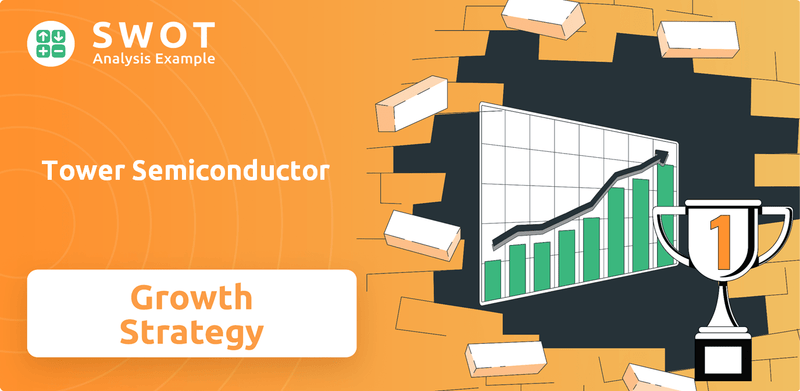
The semiconductor industry is experiencing significant expansion, with projections indicating substantial growth through 2030. This presents both opportunities and challenges for Tower Semiconductor. This article provides a comprehensive market analysis of Tower Semiconductor, including its financial performance, strategic initiatives, and future outlook, helping investors and industry professionals understand the company's potential for sustainable growth and investment opportunities within the dynamic semiconductor landscape.
How Is Tower Semiconductor Expanding Its Reach?
Tower Semiconductor's growth strategy centers on aggressive expansion initiatives designed to boost its capacity and capabilities. These efforts are crucial for capitalizing on the increasing demand within the Semiconductor Industry. The company is strategically investing in its existing facilities and forging new partnerships to strengthen its position in the market. This approach is vital for sustaining its financial performance and achieving long-term growth.
A significant portion of Tower Semiconductor's strategy involves substantial capital expenditures to enhance its global manufacturing footprint. These investments are targeted at both expanding existing fabs and incorporating advanced technologies. The company's focus on high-performance and energy-efficient chips aligns with the growing needs of key sectors such as AI, 5G, and electric vehicles. This strategic direction is essential for navigating the competitive landscape and driving future success.
Tower Semiconductor's expansion plans include a multi-faceted approach to increase its production capacity and technological capabilities. This includes investments in existing facilities and collaborations with industry partners. The company's strategic initiatives are designed to meet the growing market demands and maintain its competitive edge. For a broader understanding of the competitive environment, consider exploring the Competitors Landscape of Tower Semiconductor.
In 2024, Tower Semiconductor continued to invest heavily in its facilities. A notable investment of $350 million was allocated to enhance SiGe and SiPho capabilities in Fabs 2, 7, and 9. This strategic investment is designed to meet the increasing demand for advanced chips.
Tower Semiconductor has established a capacity corridor with Intel at its 300mm facility in New Mexico (Fab 11). This collaboration involves an investment of up to $300 million in equipment. Volume production and operations at Fab 11 commenced in the fourth quarter of 2024.
The company is also focusing on increasing its 200mm capacity at facilities in San Antonio, Texas, and Migdal Haemek, Israel. Additionally, there are plans to improve its 300mm facility in Uozu, Japan. These initiatives aim to support growing customer demand.
Tower Semiconductor withdrew from a planned $10 billion chip plant project in India with the Adani Group. This decision was made in late 2024 or early 2025. Despite this, the company remains committed to its core expansion strategies.
Tower Semiconductor is prioritizing expansion in cutting-edge technologies such as silicon photonics and silicon germanium. These technologies are critical for data centers, telecommunications, and AI-based solutions. The company is also targeting high-frequency and high-speed electronic devices.
- Silicon Photonics: Essential for high-speed data transfer in data centers.
- Silicon Germanium: Used in high-frequency and high-speed electronic devices.
- AI and 5G: Key drivers for the demand of advanced chips.
- Automotive Radar Systems: Expanding into the automotive sector.
Tower Semiconductor SWOT Analysis
- Complete SWOT Breakdown
- Fully Customizable
- Editable in Excel & Word
- Professional Formatting
- Investor-Ready Format
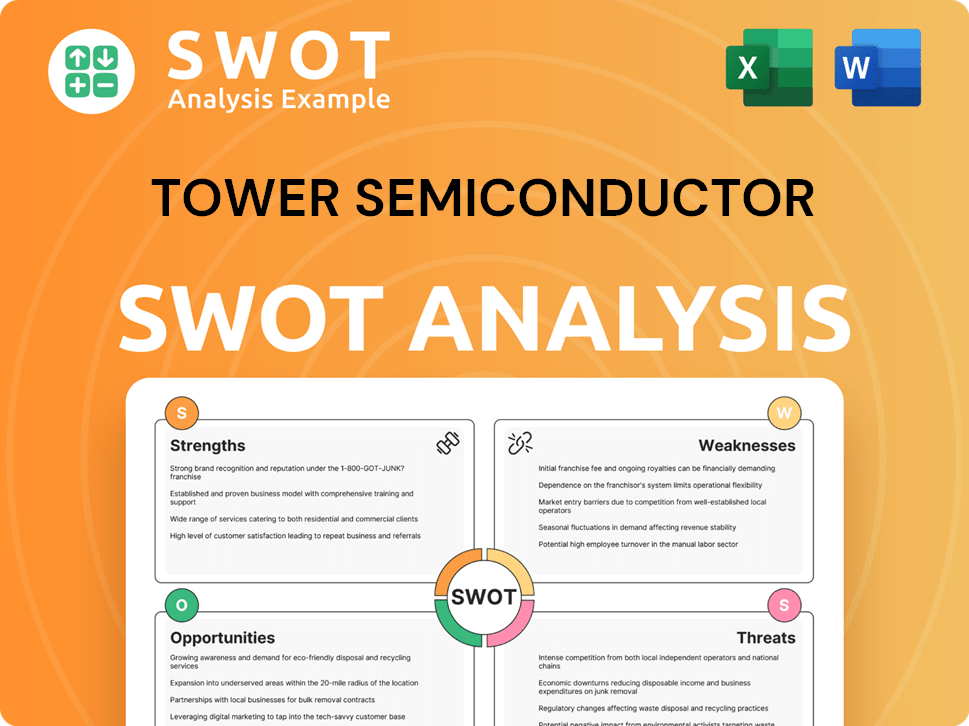
How Does Tower Semiconductor Invest in Innovation?
The innovation and technology strategy of Tower Semiconductor is crucial for its growth. The company consistently invests in research and development, offering a wide array of customizable process platforms. This focus on advanced technologies and design enablement positions Tower Semiconductor as a leading foundry for high-value analog semiconductor solutions.
Tower Semiconductor's commitment to innovation is evident in its continuous development of new platforms and technologies. This strategy helps the company meet the evolving needs of its customers. By staying at the forefront of technological advancements, Tower Semiconductor aims to maintain a competitive edge in the semiconductor industry.
The company's strategy is to offer a broad range of process platforms, including SiGe, BiCMOS, mixed-signal/CMOS, RF CMOS, CMOS image sensor, non-imaging sensors, displays, integrated power management (BCD and 700V), photonics, and MEMS. These platforms support diverse applications, from mobile devices to AI and data centers, driving the company's growth. This comprehensive approach allows Tower Semiconductor to serve a wide range of customer needs.
In late 2024, Tower Semiconductor released its new 300mm 65nm 3.3V-based BCD (Bipolar-CMOS-DMOS) Power Management platform, PML. This platform is designed to meet the stringent low-voltage requirements of mobile devices. It also addresses the growing demands for high power efficiency and power density in AI and data center applications.
Tower Semiconductor is focusing on Silicon Photonics (SiPho) and Silicon Germanium (SiGe) technologies. The company aims for revenue growth in these areas throughout 2025. The SiPho business is specifically on track to double its revenue from $105 million in 2024 within 2025.
Tower Semiconductor is actively developing advanced RF foundry technology. The company is showcasing its innovations at industry conferences, such as the International Microwave Symposium (IMS) 2025. It will present a joint white paper on an innovative SPDT switch using its PCM RF switches in RFSOI CMOS process.
The company is targeting RF infrastructure, optical transceivers, and active copper cables. These are crucial for cloud computing and AI clusters. The PML platform features LDMOS devices with ultra-low on-resistance and a best-in-class figure-of-merit, enabling high power conversion efficiency.
The PML platform enables high power conversion efficiency for fast switching converters. This innovation directly contributes to growth objectives. It empowers customers to develop industry-leading products with a competitive edge in strategic markets.
Tower Semiconductor participates in industry events to showcase its innovations. Its presence at IMS 2025 highlights its leadership in developing advanced RF foundry technology. The company focuses on 5G, future 6G, SatCom, beamforming, and millimeter-wave applications.
Tower Semiconductor's technology roadmap includes advancements in several key areas. These innovations are crucial for the company's future outlook and strategic initiatives. The company's focus on these technologies is expected to drive its financial performance.
- Silicon Photonics (SiPho): Critical for optical transceivers and data centers.
- Silicon Germanium (SiGe): Used in RF infrastructure and high-performance applications.
- Power Management: The new PML platform for mobile devices and AI applications.
- RF Technology: Advanced RF foundry technology for 5G, 6G, and millimeter-wave applications.
- Market Focus: Targeting cloud computing, AI clusters, and mobile devices for growth.
Tower Semiconductor PESTLE Analysis
- Covers All 6 PESTLE Categories
- No Research Needed – Save Hours of Work
- Built by Experts, Trusted by Consultants
- Instant Download, Ready to Use
- 100% Editable, Fully Customizable
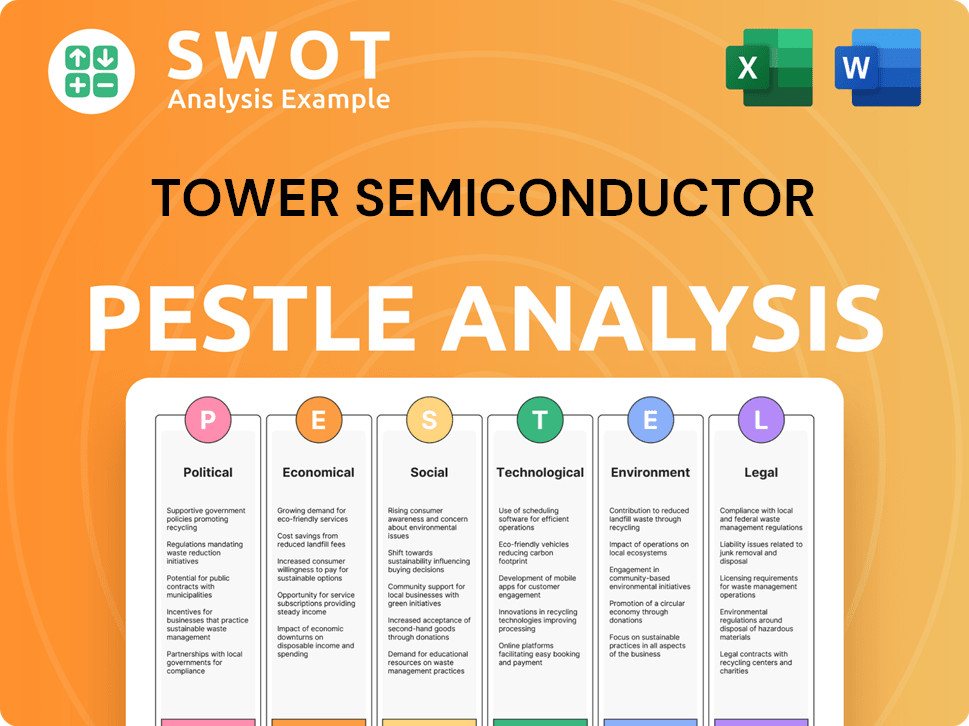
What Is Tower Semiconductor’s Growth Forecast?
The financial outlook for Tower Semiconductor in 2025 is positive, with a focus on achieving year-over-year revenue growth. This strategy includes sequential quarter-over-quarter increases, particularly accelerating in the second half of the year. This is supported by strategic investments in capacity expansion and new operational capabilities globally.
In the first quarter of 2025, Tower Semiconductor reported revenues of $358 million, marking a 9% year-over-year increase compared to $327 million in Q1 2024. The company's guidance for the second quarter of 2025 projects revenues of $372 million, with a potential variance of 5%, reflecting a 6% year-over-year revenue increase. This demonstrates a solid growth strategy.
Analysts anticipate significant growth for the company, forecasting earnings to increase by 14.9% annually and revenue by 9.9% per year. Earnings per share (EPS) are expected to rise from $1.67 to $2.24 in the next year, representing a 34.13% increase. As of March 2025, total assets were $3.1 billion, and shareholders' equity reached $2.7 billion.
Tower Semiconductor's revenue for Q1 2025 was $358 million, up 9% year-over-year. The company anticipates continued revenue growth in Q2 2025, projecting $372 million.
The EPS is expected to grow from $1.67 to $2.24 in the next year, a 34.13% increase. This indicates strong financial performance and future growth potential.
Gross profit for Q1 2025 remained stable at $73 million. Net profit for Q1 2025 was $40 million, with $0.35 diluted earnings per share.
Tower Semiconductor is making significant capital expenditures for capacity expansion and new operational capabilities. These investments are crucial for long-term growth.
As of March 2025, total assets were $3.1 billion, and shareholders' equity reached $2.7 billion. Standard & Poor's Maalot reaffirmed Tower's corporate credit rating as 'ilAA' with a stable outlook on May 7, 2025.
Analysts forecast the company's earnings to grow by 14.9% per year and revenue by 9.9% per year. This positive outlook supports the company's Tower Semiconductor Future.
Tower Semiconductor Business Model Canvas
- Complete 9-Block Business Model Canvas
- Effortlessly Communicate Your Business Strategy
- Investor-Ready BMC Format
- 100% Editable and Customizable
- Clear and Structured Layout
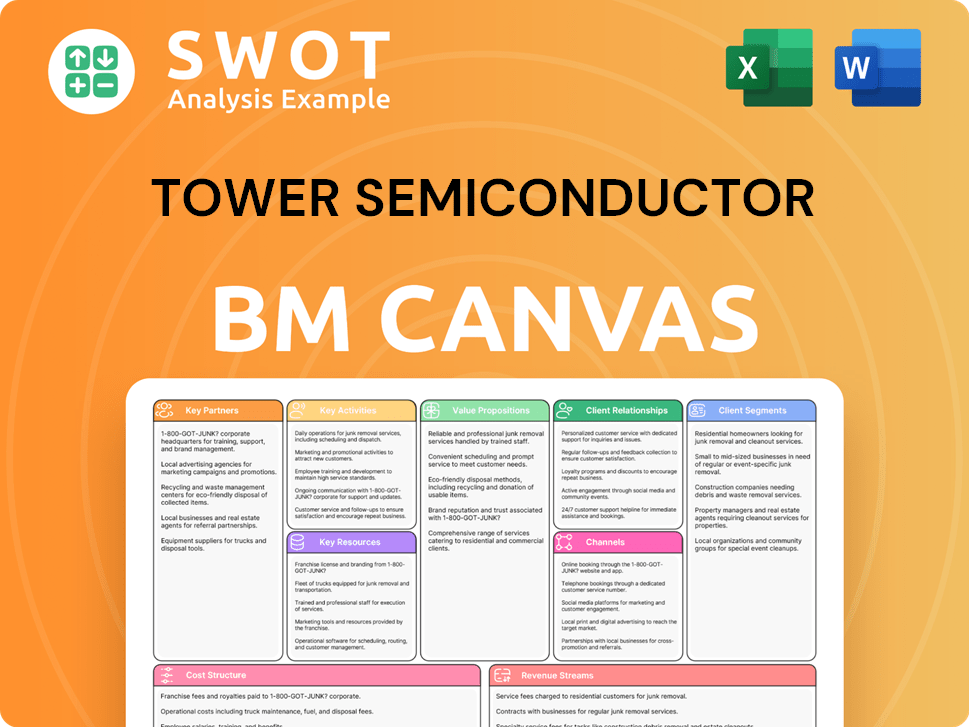
What Risks Could Slow Tower Semiconductor’s Growth?
The Tower Semiconductor faces various risks that could impact its growth strategy. The Semiconductor Industry is competitive, and demand fluctuations in customer markets can lead to significant challenges. These factors necessitate a careful evaluation of potential obstacles.
Regulatory changes and geopolitical tensions add further layers of complexity. Supply chain vulnerabilities and cybersecurity threats are also critical concerns. Furthermore, the company's reliance on capacity expansion and acquisitions introduces additional risks that must be addressed for sustainable growth.
The company's future outlook is also affected by the ongoing conflict in Israel, where it has facilities. The situation's instability could materially impact operations.
The semiconductor foundry business is highly competitive, with competitors potentially having advantages. The ability to compete effectively is crucial for success. Tower Semiconductor must continually innovate and adapt to maintain its market position.
Demand in customers' end markets is cyclical and volatile. Downturns can lead to inventory buildup and reduced orders. For example, analog chip inventories have recently increased, primarily due to oversupply and reduced demand in the automotive industry.
Trade restrictions and geopolitical tensions can affect supply chains and increase prices. Export controls on critical chip metals and varying compliance requirements across jurisdictions pose additional risks. The company leverages its global manufacturing flexibility to mitigate potential effects.
Semiconductor manufacturing is geographically concentrated, making the industry susceptible to natural disasters. Cybersecurity threats, including data breaches and intellectual property theft, also present significant risks. These vulnerabilities can disrupt operations and impact financial performance.
Reliance on capacity expansion and potential acquisitions carries risks. The return on these investments may be lower than expected, potentially reducing net profit and cash balance. Additional funding could be required, affecting the company's financial reports.
The ongoing conflict in Israel could materially and adversely affect the operations of Tower Semiconductor's Israeli facilities if instability in neighboring states occurs. This could disrupt production and impact the company's overall performance. To learn more about the company's target market, read the article: Target Market of Tower Semiconductor.
The handset market is forecasted to experience flat to minimal growth in 2025, which will affect RF-SOI customers. This flat growth indicates a need for Tower Semiconductor to diversify its product offerings. The company must focus on new product development.
The semiconductor industry faces a complex regulatory environment with varying compliance requirements. Noncompliance can lead to significant fines and operational disruptions. Tower Semiconductor must prioritize compliance to avoid penalties and maintain smooth operations. A strong sustainable growth strategy is required.
Given the concentration of manufacturing, Tower Semiconductor needs robust supply chain management. This includes diversifying suppliers and having contingency plans for natural disasters and other disruptions. Effective supply chain management is a key growth driver.
Capacity expansion and acquisitions can be risky. The company's strategic initiatives must be carefully planned and executed. Investors should assess the potential risks associated with these initiatives. Tower Semiconductor's stock performance is linked to these factors.
Tower Semiconductor Porter's Five Forces Analysis
- Covers All 5 Competitive Forces in Detail
- Structured for Consultants, Students, and Founders
- 100% Editable in Microsoft Word & Excel
- Instant Digital Download – Use Immediately
- Compatible with Mac & PC – Fully Unlocked
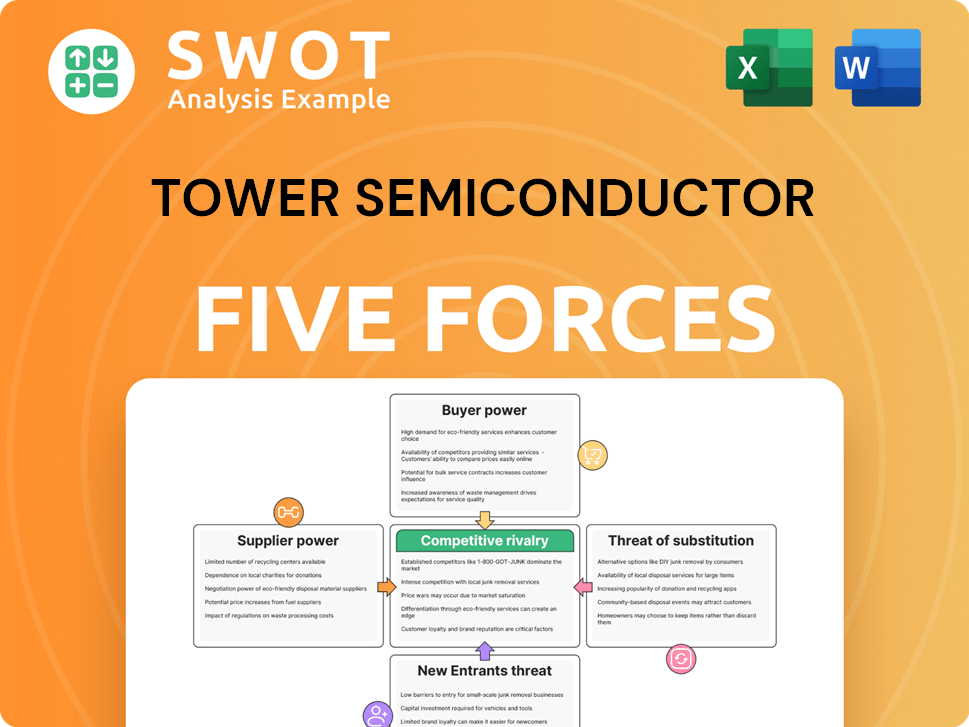
Related Blogs
- What are Mission Vision & Core Values of Tower Semiconductor Company?
- What is Competitive Landscape of Tower Semiconductor Company?
- How Does Tower Semiconductor Company Work?
- What is Sales and Marketing Strategy of Tower Semiconductor Company?
- What is Brief History of Tower Semiconductor Company?
- Who Owns Tower Semiconductor Company?
- What is Customer Demographics and Target Market of Tower Semiconductor Company?
Disclaimer
All information, articles, and product details provided on this website are for general informational and educational purposes only. We do not claim any ownership over, nor do we intend to infringe upon, any trademarks, copyrights, logos, brand names, or other intellectual property mentioned or depicted on this site. Such intellectual property remains the property of its respective owners, and any references here are made solely for identification or informational purposes, without implying any affiliation, endorsement, or partnership.
We make no representations or warranties, express or implied, regarding the accuracy, completeness, or suitability of any content or products presented. Nothing on this website should be construed as legal, tax, investment, financial, medical, or other professional advice. In addition, no part of this site—including articles or product references—constitutes a solicitation, recommendation, endorsement, advertisement, or offer to buy or sell any securities, franchises, or other financial instruments, particularly in jurisdictions where such activity would be unlawful.
All content is of a general nature and may not address the specific circumstances of any individual or entity. It is not a substitute for professional advice or services. Any actions you take based on the information provided here are strictly at your own risk. You accept full responsibility for any decisions or outcomes arising from your use of this website and agree to release us from any liability in connection with your use of, or reliance upon, the content or products found herein.